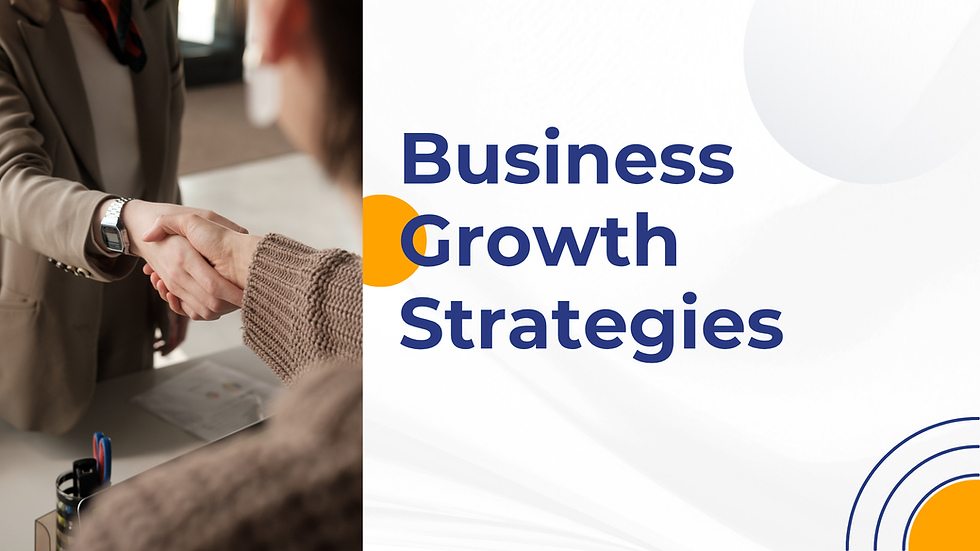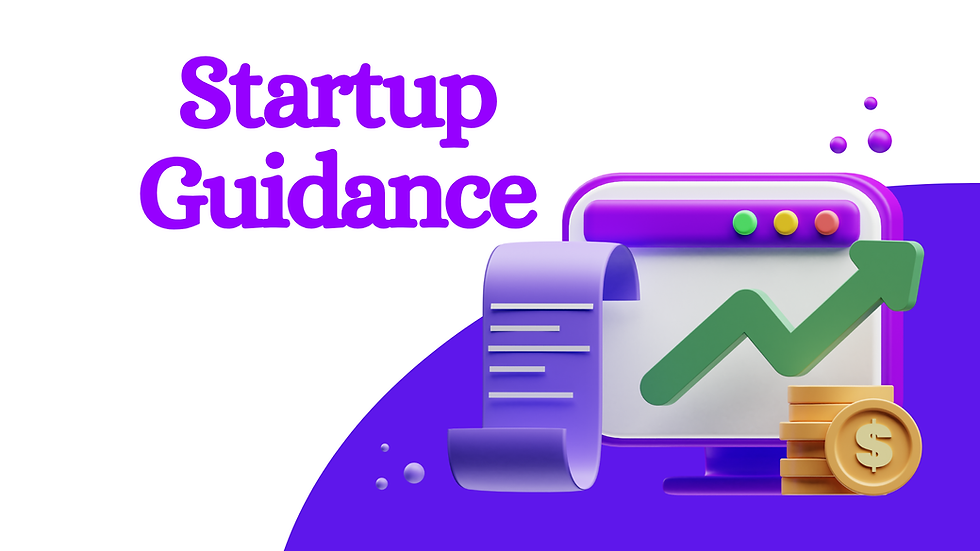Business Growth Strategy in 2025: A Complete Guide to Scaling Smart and Sustainable
- Your Digital Marketing Mentor

- 7 hours ago
- 8 min read
TL;DR
A business growth strategy is a structured plan to increase revenue, expand market share, and strengthen long-term sustainability.
Core elements include market research, customer acquisition, branding, innovation, and financial planning.
In 2025, AI-driven tools, digital ecosystems, and mentorship are transforming how businesses accelerate growth.
Utilizing content marketing helps attract and engage target audiences, building credibility and improving search engine rankings.
Common growth models: market penetration, diversification, product development, and partnerships.
The right business growth strategy saves time, reduces risk, and helps companies scale effectively in competitive markets.
Last updated: 2025-09-26
What Is a Business Growth Strategy?
A business growth strategy is more than just a plan to increase sales. It’s a smart framework that guides your company’s growth by aligning vision, market insights, and resources. Researching the state of your industry is the best way to determine if desired growth is both necessary and feasible. This strategy helps you build scalable systems, strengthen your customer base, and position your business for long-term success.
Think of it as your roadmap to navigate changing market dynamics and seize growth opportunities. Whether you’re in the early stages or an established business, having a clear strategy helps you achieve growth sustainably and avoid costly mistakes.
Why is this important? Because pursuing growth without a strategy is like sailing without a compass. You might move, but you won’t know if you’re headed in the right direction.
Why Business Growth Strategy Matters in 2025
The business landscape is shifting fast. Here’s why having an effective growth strategy is crucial now:
AI disruption: AI and GPT technologies are reshaping industries, offering new ways to understand customers and optimize operations.
Global competition: Digital-first companies enter markets quickly, increasing pressure on small businesses and startups.
Sustainability focus: Investors and customers prefer businesses with models that emphasize long term success and ethical practices. Sustainable growth strategies integrate environmental, social, and governance practices into a company's core strategy.
Customer expectations: Today’s consumers expect personalization, speed, and transparency.
Expanding digital marketing efforts through social media, email campaigns, and a user-friendly website can increase brand awareness.
High failure rates: 70–90% of startups fail within 5 years. A solid growth strategy improves your odds.
Monitoring industry shifts and customer preferences enables timely adaptation for growth.
In short, pursuing growth without a plan is risky. A strategy combined with execution is your best bet for success.
Core Elements of a Business Growth Strategy
To build a successful business growth strategy, focus on these key elements:
Element | Focus | Why It Matters |
Market Research | Customers, competitors, trends | Understand your target audience and industry trends to spot growth opportunities. |
Value Proposition | Unique problem-solving message | Differentiate your brand in established markets and existing markets. |
Customer Acquisition | SEO, paid ads, partnerships | Bring in new customers and grow your customer base. |
Innovation | Products, services, processes | Stay competitive by evolving your product line and services. |
Branding | Awareness, trust, storytelling | Build customer loyalty and attract loyal customers. |
Financial Planning | Budgeting, forecasting, KPIs | Ensure revenue growth is sustainable and profitable. |
Mentorship & Networks | Expert insights, accountability | Accelerate learning and continuous improvement. |
Proven Business Growth Models
Understanding different growth strategies helps you pick the right path. Here are the most common models:
1. Market Penetration Strategy
This focuses on selling more to your existing markets and customer segments. It’s about increasing market share with current products. Market penetration focuses on increasing market share in existing markets.
Example: Starbucks used loyalty programs to encourage repeat purchases, boosting sales in established markets.
2. Product Development
Create new products or improve existing ones for your current customers. This taps into the customer base you’ve already built.
Example: Apple expanded its product line by introducing wearables after iPhone success.
3. Market Development
Enter new target markets or customer segments. This could mean expanding geographically or targeting new demographics.
Example: Netflix grew by moving from the U.S. into global markets, reaching new customer segments.
4. Diversification
Launch new products in new markets. This is riskier but can open entirely new revenue streams. Diversification is the strategy of developing new products for new markets, presenting high potential returns but also high risks.
Example: Amazon diversified from bookselling to cloud computing with AWS.
5. Strategic Partnerships and Alliances
Collaborate with other businesses to leverage strengths and enter new markets faster.
Example: Spotify partnered with Uber to enhance rider experience, expanding reach.
Types of Business Growth: What Are Your Options?
Businesses grow in different ways. Knowing the types of business growth helps you choose the best fit for your company’s goals. Small business growth strategies often include a combination of market penetration, product development, market expansion, and diversification.
Organic Growth: Growth from internal resources, like improving sales or marketing efforts. It’s sustainable and low risk.
Strategic Growth: Involves partnerships, acquisitions, or alliances to accelerate expansion.
Internal Growth: Focuses on improving operational efficiency to boost profitability without expanding market reach.
Acquisition Growth: Buying other companies to increase market share or product offerings quickly.
Companies often benefit most from pursuing multiple growth strategies simultaneously in a harmonized manner.
Each type has pros and cons. For example, organic growth saves money and builds a solid foundation, while acquisition growth can be faster but riskier.
Step-by-Step: Building Your Business Growth Strategy
Ready to build your roadmap? Here’s a simple step-by-step guide:
Creating a detailed growth strategy document enhances understanding and buy-in among team members.
Step 1: Define Your Vision & Objectives

Where do you want your business in 1, 3, and 5 years?
Set SMART goals (Specific, Measurable, Achievable, Relevant, Time-bound).
Ask yourself: What does success look like?
Developing a tactical action plan outlines projects, timelines, and responsibilities for growth initiatives.
Establishing Objectives and Key Results (OKRs) keeps stakeholders aligned and focused on critical growth areas.
Step 2: Conduct Market & Competitor Research
Use tools like SEMrush, Similar Web, or Statista.
Identify gaps your brand can fill in existing markets or explore market expansion.
Understand customer expectations and industry trends.
Identifying new potential customers will inform product expansion for target markets, which sets the stage for an effective business growth plan.
Step 3: Refine Your Value Proposition
Clarify why customers should choose you over competitors.
Highlight your competitive advantage.
Step 4: Choose Growth Channels
Organic growth: SEO, content marketing.
Paid growth: ads, sponsorships.
Strategic growth: partnerships, affiliates.
Step 5: Build Scalable Systems
Automate workflows with tools like HubSpot, Notion, or Zapier.
Automating internal systems can enhance efficiency and support growth.
Document processes for hiring and training.
Step 6: Track & Optimize
Measure growth metrics like CAC (Customer Acquisition Cost), CLV (Customer Lifetime Value), churn rate, and profit margin.
Adjust quarterly based on performance and market conditions.
Digital Growth Strategies for 2025
Harness technology and data to accelerate growth:
AI-powered insights: Use predictive analytics to anticipate customer behavior and optimize marketing efforts.
Personalized marketing: Tailor campaigns to potential customers and target audience preferences.
Community building: Create loyal brand advocates online.
Sustainability positioning: Align your brand with eco-conscious values.
Omnichannel sales: Provide consistent experiences across digital and offline touchpoints.
A professional, mobile-friendly website serves as a digital storefront and can significantly boost visibility.
Social proof is central to successful sales copywriting and broader content marketing efforts because it says, 'Hey, people trust us.'
Driving Growth Through Customer Experience and Service
Growth isn’t just about acquiring more customers; it’s about keeping them happy. To provide excellent customer service and meet rising customer expectations, focus on:
Listening actively to customer feedback.
Offering fast and helpful support.
Personalizing interactions to enhance the customer experience.
Rewarding satisfied customers through loyalty programs.
Using customer feedback to refine products and services increases their quality and value.
Customer retention is often cheaper and more effective than constantly chasing new customers.
Existing customers already love your brand and may evangelize for you for free.
Remember, excellent customer service drives repeat business and referrals, which are key to sustainable growth.
Customer retention offers one of the best ROIs, so it's definitely worth investing in.
Operational Efficiency: The Backbone of Growth
As your business expands, operational efficiency becomes critical. Improving internal processes helps you:
Save money by reducing waste and streamlining workflows.
Scale without sacrificing quality.
Respond faster to market changes.
Support growth initiatives with the right resources.
Investing in employees can improve productivity and retention.
Investing in employee training and recognition can drive productivity and enhance customer experiences.
Using tools like templates helps keep teams aligned and accountable toward growth objectives.
Word-of-mouth is organic and effective, as recommendations from friends and family are some of the most powerful incentives for consumers to purchase or try a product.
Investing in technology and training can boost operational efficiency, helping you weather economic downturns and stay competitive.
Strategic Alliances: Strength in Numbers
Forming strategic alliances can accelerate growth by:
Opening access to new markets and total addressable market.
Sharing resources and expertise.
Reducing risks associated with entering new markets.
Building strategic partnerships can expand a business's reach and access new customers without the full financial commitment of an acquisition.
Milestone referrals offer rewards for hitting specific benchmarks, which can significantly enhance customer engagement.
Successful companies often leverage partnerships to complement their strengths and reach more customers faster. Loyal customers not only drive predictable revenue streams but also act as powerful brand advocates.
Measuring Success: How to Know You’re Growing
You can’t improve what you don’t measure. Use clear metrics to measure success:
Revenue growth rate.
Market share increase.
Customer acquisition and retention rates.
Profit margins and operational costs.
Customer satisfaction scores.
Using data and analytics helps in tracking performance and gaining insights into customer behavior for data-driven decisions.
Revenue growth rate.
Market share increase.
Customer acquisition and retention rates.
Profit margins and operational costs.
Customer satisfaction scores.
Tracking these regularly keeps your strategy focused and allows adjustments to stay on course.
Implementation Checklist
✅ Define 2–3 SMART growth goals.✅ Conduct in-depth market & competitor analysis.✅ Refine your value proposition & messaging.✅ Select 2–3 growth channels.✅ Set tracking metrics and review quarterly.✅ Build scalable systems and automate where possible.✅ Focus on excellent customer service and customer experience.✅ Explore strategic alliances and partnerships.✅ Monitor operational efficiency and optimize regularly.✅ Use AI and digital tools for insights and personalization.
Decision Table: Choosing the Right Growth Path
Situation | Best Strategy | Why |
Strong product, weak sales | Market penetration | Focus on awareness & acquisition in established markets. |
Many customers, stagnant offerings | Product development | Keeps existing customers engaged with new products. |
Local business, growing demand | Market development | Access new customer segments and regions. |
High risk tolerance | Diversification | Spread risk and open new revenue streams. |
Limited resources, strong networks | Strategic alliances | Leverage external strengths for faster growth. |
FAQ: Business Growth Strategy
Q1: What is the first step in creating a growth strategy? Start with defining your vision and conducting market research to ensure product-market fit.
Q2: How long should a growth strategy plan cover? Most businesses plan in 1–3 year cycles with quarterly reviews.
Q3: Do I need investors for growth? Not always. Many companies bootstrap growth or use strategic partnerships before raising capital.
Q4: What KPIs should I track? Customer Acquisition Cost, Lifetime Value, churn rate, profit margins, and ROI on marketing spend.
Q5: How do I know if my growth strategy is working? Measure progress against SMART goals and adjust quarterly.
Final Thoughts
An effective business growth strategy is your compass to navigate market dynamics and build a successful business. By combining clear vision, customer insights, digital tools, and mentorship, you can thrive in today’s competitive environment. Regularly revisiting and adjusting a growth strategy maintains alignment with evolving market conditions.
If you want to accelerate your growth journey and need guidance, reach out to a mentor who can help you craft and execute your strategy.
👉 Need a mentor? Contact us today at https://www.webmarketingmentor.com/contact-1




Comments